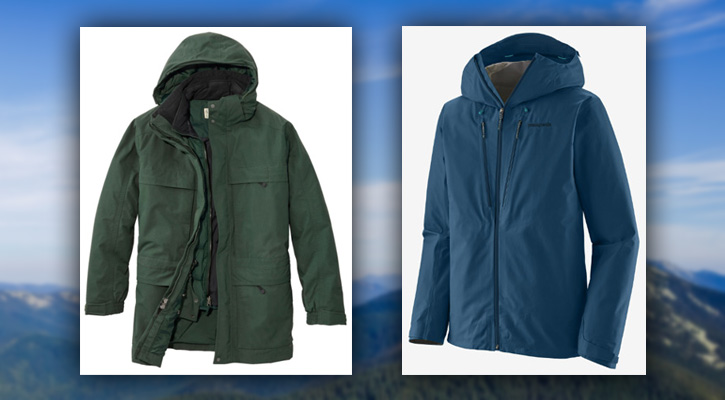
Whether you’re trekking through the forest or braving the mountain cold, picking the right equipment is crucial.
L.L. Bean has been outfitting nature lovers for over a century with a legacy that starts in the heart of Maine.
On the other hand, Patagonia brings its own blend of eco-conscious innovation and rugged durability to the table.
In this article, we’ll compare these two iconic brands on everything from their history and products to their quality and prices.
Let’s begin!
Contents:
1. L.L. Bean Outdoor Gear
History of the Brand
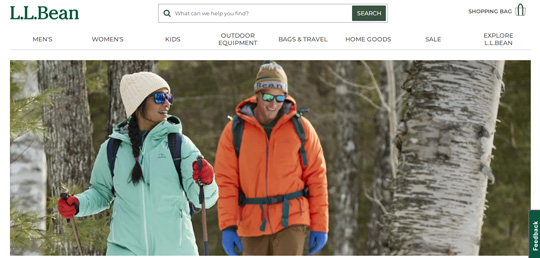
L.L. Bean’s official website
L.L. Bean‘s rich history dates back over a century to 1912 when it was established in Freeport, Maine. The company’s headquarters remain in the same location to this day.
Founded by Leon Leonwood Bean, an avid fisherman and hunter, the brand initially specialized in the Maine Hunting Shoe, a waterproof, lightweight rubber boot ideal for outdoor enthusiasts. Over time, the product line expanded to meet the growing demand for high-quality goods.
Presently, L.L. Bean operates over 50 retail stores in the United States and Japan, in addition to its global online presence. The brand has garnered attention in various television programs and has also established the Outdoor Discovery Schools focused on providing nature-based education and excursions.
Renowned for its innovation and superior craftsmanship, L.L. Bean offers a diverse range of unique products not commonly found elsewhere.
Don’t miss: 9 Quality Brands like L.L. Bean: Our Top Picks
Materials, Fabrics, and Production Process
Brands such as L.L. Bean, known for their emphasis on high-performance products, do not exclusively depend on traditional materials like polyester or nylon for their performance wear. Instead, they integrate established technologies and may even develop their own.
For example, L.L. Bean utilizes top-tier fabrics like Gore-Tex, renowned for its exceptional durability, weather resistance, and breathability, as well as materials from Loomia and PrimaLoft for their synthetic insulation.
They also incorporate waxed cotton to enhance weather resistance in lightweight, comfortable jackets. Their winter coats feature natural down insulation and high-quality synthetic insulation from PrimaLoft, ensuring reliable warmth in extreme weather conditions.
The video will be loaded from YouTube.com, a third party. If you play it, you accept their terms of service, and their use of cookies.
Read also: Eddie Bauer vs L.L. Bean Outdoor Gear: A Comparison
Where is L.L. Bean outdoor gear made?
L.L. Bean makes a significant portion of its products in the United States, in Maine. This includes several of the company’s timeless and unique creations, including their footwear. However, a considerable part of their other gear is manufactured in various facilities worldwide, mainly in Asia.
Recommended Products
L.L. Bean Men’s Maine Warden’s 3-in-1 GORE-TEX Parka
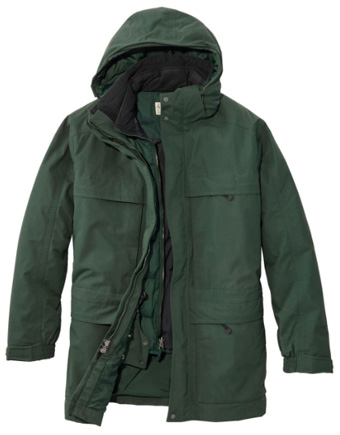
Image: llbean.com
Check it out at LLBean.com
The L.L. Bean Men’s Maine Warden’s 3-in-1 Parka is a robust and versatile jacket crafted to endure harsh temperatures, benefiting from the knowledge of Maine wardens. It boasts a resilient GORE-TEX outer layer for reliable waterproof and windproof defense and incorporates a detachable, down-insulated inner jacket for extra insulation.
This parka is tailored to offer extensive coverage, extending below the hip, and has an array of pockets for functional storage. Made from ripstop nylon, for the parka’s outer shell, and primarily nylon and polyester for the inner components, the entire garment is machine washable for effortless maintenance.
With a classic fit intended for wear with midweight layers, it includes features such as a removable hood, side zips for flexibility, and a drawcord waist for heat retention. The 3-in-1 design of the parka provides layers that can be worn together or separately, catering to diverse weather conditions.
Despite its high protection, the parka maintains a practical weight, rendering it suitable for outdoor pursuits.
Don’t miss: Lands’ End vs L.L. Bean Outdoor Gear: Which is Better?
L.L. Bean Women’s Ridge Runner Backpack, 48L
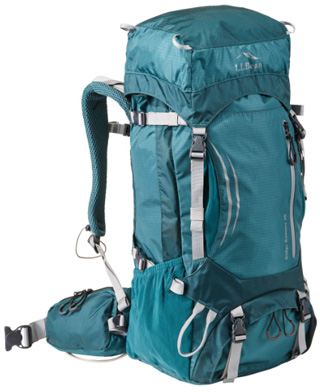
Image: llbean.com
Check it out at LLBean.com
The L.L. Bean Women’s Ridge Runner Backpack is a well-crafted and durable backpack designed specifically for women and is great for weekend hiking. It comes in two sizes to accommodate different torso lengths and offers a generous 48-liter capacity while remaining lightweight.
Constructed from strong 100D triple ripstop nylon with a 210D nylon lining, it’s built to endure the demands of hiking. The backpack’s structure is reinforced by a back panel with pre-bent stays, and it ensures comfort with a mesh-covered foam back panel and shoulder straps that encourage airflow.
The pack is equipped with a spacious main compartment, easily accessible zipper, stretch mesh water bottle pockets, and additional gear loops. For added convenience, it includes a front shove-it pocket, a fleece-lined pocket for delicate items, and an interior pocket with a key fob.
The hydration sleeve supports up to a 2-liter bladder, enabling easy hydration while on the move.
Prices
When it comes to pricing, L.L. Bean stands out as a mixed brand due to its extensive range of prices. Their jackets are available at prices from $70 to $500, while their backpacks range from $50 to $220. This shows the diverse and abundant pricing options offered by L.L. Bean for all customers.
Are L.L. Bean products worth the price?
L.L. Bean is known for its strong reputation for delivering comfortable and high-quality products. Depending on your needs, the cost of their designs is worth it in most cases in our opinion. Their jackets offer comfort, excellent performance, and simple designs.
Must read: 9 Expensive Hiking Brands for Clothing and Footwear
2. Patagonia Outdoor Gear
History of the Brand
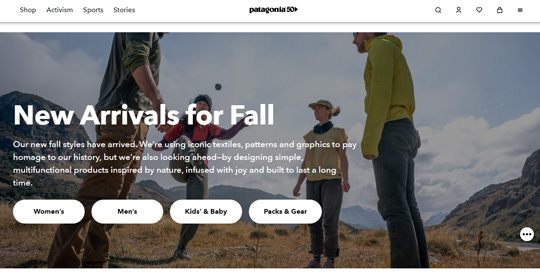
Patagonia official website
The origins of Patagonia can be traced back to 1957 when Yvon Chouinard, a passionate climber, started learning blacksmithing. That year, he crafted and sold his first pitons to fellow climbers. Later, Chouinard set up a modest workshop in Burbank to produce climbing equipment, which he personally distributed throughout California.
By 1965, a partnership with Tom Frost resulted in the establishment of Chouinard Equipment, eventually leading to the formation of Patagonia as a separate apparel brand in 1973, following the division of Chouinard Equipment.
Don’t miss:
9 Brands Like Patagonia for Sustainable Outdoor Clothing
12 Best American Jackets and Outdoor Clothing Brands
Materials, Fabrics, and Production Process
Patagonia believes that every individual’s actions have a global impact. The brand uses recycled materials, such as fishing nets, cashmere, wool, polyester, and cotton, in its premium clothing and outdoor equipment.
Nylon, Polyester, H2No, and Gore-Tex are some of Patagonia’s main materials and technologies incorporated into their jackets and other gear. Recycled down is utilized for insulation, along with PrimaLoft synthetic insulation, and the fabrics undergo thorough testing.
In the outdoor community, Patagonia is well-known for its commitment to sustainability, ethical labor practices, environmental activism, and donations to environmental causes.
The video will be loaded from YouTube.com, a third party. If you play it, you accept their terms of service, and their use of cookies.
Read also: Patagonia vs Helly Hansen: Which Brand is Better?
Where is Patagonia outdoor gear made?
Patagonia’s outdoor equipment is mostly manufactured in China, Vietnam, Sri Lanka, Mexico, Thailand, and several other nations, with a minor portion produced in the United States.
Recommended Products
Patagonia Triolet Men’s Jacket
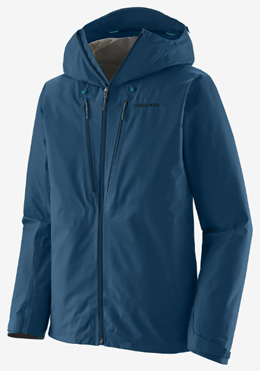
Image: patagonia.com
Check it out at Patagonia.com
The Triolet Men’s Jacket is built for harsh cold and snowy conditions. Made of a 3-layer GORE-TEX fabric, it offers waterproof, breathable, and windproof protection, and has a 100% recycled polyester exterior for enhanced durability.
The jacket is PFC-free and is made in a Fair Trade Certified facility. It features two chest pockets with watertight zips, a helmet-compatible hood, two welted front pockets, and an interior pocket.
It’s designed with welted, watertight two-way pit zips for extra ventilation and a dual-adjust drawcord hem to effectively block out the elements. It also includes a concealed RECCO® reflector for enhanced visibility. The jacket is produced in Vietnam.
Read next: Mountain Hardwear vs Patagonia (Outdoor Gear Comparison)
Patagonia Terravia 28L Pack
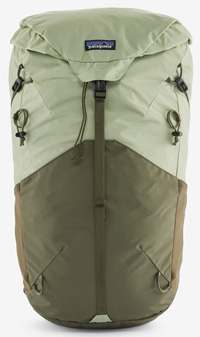
Image: patagonia.com
Check it out at Patagonia.com
The versatile Terravia 28L Pack is perfect for day trips or slightly longer hikes. With a 28-liter capacity, it is made from durable 100% recycled nylon, combining strength with sustainable production. The backpack has a breathable back panel and shoulder straps, a front-loading stuff pocket, and an automatic lid closure.
Its suspended mesh back panel design ensures great airflow and moisture prevention for maximum comfort. The Regulator® airmesh shoulder straps and hip belt offer a comfortable fit, while easily accessible side pockets and hydration compatibility add convenience.
It comes with a rain cover, zippered lid, and internal security pockets for your objects.
Don’t miss: The North Face vs Patagonia: Which is Better?
Prices
Patagonia is popular as a premium brand among outdoor enthusiasts. Their jackets are priced from around $130 to $700, while their backpacks fall within the range of $70 to $300.
Are Patagonia products worth the price?
We think that the gear made by Patagonia is worth the initial investment. The company is dedicated to using sustainable resources, advocating for environmental conservation, and delivering high-quality items that last for many adventures.
Learn more: Why Is Patagonia So Expensive and Popular? Are Its Jackets Worth It?
3. Which is Better? L.L. Bean or Patagonia?
Patagonia is very famous among mountaineers and outdoor enthusiasts. L.L. Bean is highly appreciated for its boots and jackets. Here’s what to keep in mind for your decision:
- L.L. Bean has a long history as an outdoor brand, known for its boots, jackets, flannels, and other classic outdoor staples. Their gear is affordable while still being of decent quality.
- Patagonia is seen as a premium outdoor brand, focused more on high-performance technical gear. Their products are pricier but made with sustainable practices and technical materials (H2No, Gore-Tex, etc.).
- For basic layers and casual outdoor wear, L.L. Bean offers better value in our opinion. Their fleeces, flannels, and jackets are warm and durable without breaking the bank.
- For highly technical gear for activities like climbing and mountaineering, Patagonia is probably the better choice. Their focus is on innovative materials and construction for extreme conditions.
- Patagonia also has a strong reputation for sustainability and corporate responsibility. They use a lot of recycled materials and transparency in their supply chain.
- L.L. Bean has expanded into more technical categories in recent years but still excels at heritage-inspired outdoor gear for casual use.
In the end, for gear you plan to really put to the test in extreme environments, Patagonia is our suggestion. For more casual outdoor wear, L.L. Bean is a reliable choice at lower prices.
Read next: 10 Oldest Outdoor Clothing and Gear Brands
